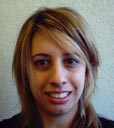Stefano PANEBIANCO
CEA-Saclay
stefano.panebianco@cern.ch

I am currently working for my Ph.D. thesis on COMPASS, an experiment taking data on the SPS at CERN. I work on analysis for the extraction of DeltaG, the gluonic contribution to the spin of the nucleon. I am presently involved in the study of open charm production, which is a clean signature of photon-gluon fusion mechanism. My contribution concerns the extraction of a D0 resonance peak, filtered out from a great combinatorial background. I am also responsable of a Drift Chamber system built by CEA/Saclay that is installed in the Large Angle Spectromiter in COMPASS. I am in charge of the commissioning, calibration and the software integration of this detector into the reconstruction program.
Valeria PEREZ REALE
University of Bern
Valeria.Perez.Reale@cern.ch

My Ph.D. thesis work involves participation in the High Level Trigger of the ATLAS experiment, one of the detectors of the proton-proton collider of the LHC experiment at CERN. ATLAS has a three level trigger system to accept the high 40 MHz bunch crossing frequency of the proton-proton collisions and reduce it to a manageable rate of roughly 200 Hz. The Trigger system has to be highly efficient in the selection of interesting physics events in the challenging LHC environment. I have been actively involved in the online HLT trigger electron identification concerning performance of the selection at different luminosities (efficiency, background rejection and event rate calculation) and the system performance of the algorithms involved in the selection. These performance studies have proven that the modular and flexible event selection scheme of the HLT is efficient to select real physics processes. Currently I am involved in performance and trigger menu studies of the decay channel of the higgs boson H->ZZ*->4e with mH=130 GeV which provides a clean signature to be detected at LHC in the mass range between 120 GeV and 180 GeV.
Jonatan PIEDRA
Instituto de Fisica de Cantabria
piedra@fnal.gov

For my Ph.D. thesis I am working on CDF, one of the two universal detectors operating at Tevatron ppbar collider at Fermilab. During my first years at CDF I have performed the offline calibrations of the Time-of-Flight detector at CDF, needed to reach resolutions of the order of 150 ps for particle ID, specially for pion-kaon separation in B physics. Right now I am measuring the oscillation frequency of the Bd meson in fully reconstructed hadronic decays, in particular Bd -> D- pi+, D- -> K+ pi- pi-. This decay as well as other hadronic decays are possible thanks to the inclusion of the Silicon Vertex Trigger, which allows selecting events containing displaced tracks.
Damien PRIEUR
LAPP
prieur@lapp.in2p3.fr

I am working for my phD in the ATLAS experiment since march 2002 and I am involved in the Liquid Argon Collaboration. I have been working on mainly two subjects; the first one is the calibration of the barrel electromagnetic calorimeter modules. Four modules (1/32 of the total barrel) of the calorimeter have been tested in the 245 GeV electron beam of the H8 line at CERN. I have studied these data and more particularly the energy reconstruction, in order to evaluate calorimeter's performances in terms of resolution and uniformity. The second subject concerns SUSY GMSB models. These models lead to long lived neutralinos. I am currently trying to study the influence of calorimeter's performances in the determination of the neutralino lifetime.




